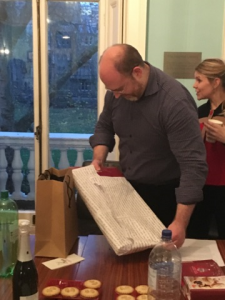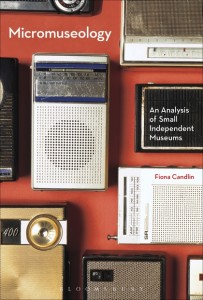It’s the final day of the Autumn term, and most of you on taught courses will already have had your last classes before the Christmas break. I think only those BA and Graduate Certificate students taking Dr. Nick Lambrianou’s level 6 course, ‘Art Writing/Writing Art’, or the MA students on Dr. Nick Lambert’s ‘Art and Photography in the Twenty-First Century’, have classes tonight. Those of you studying that MA option with Nick Lambert will know that he is leaving Birkbeck at Christmas, to take up an exciting new role as Head of Research at Ravensbourne. It’s a wonderful opportunity for Nick, but very sad for all of us in the School of Arts. We raised some glasses and said some words of thanks to Nick after our departmental meeting last week, and here are some nice pictures of him getting his leaving present. (It says much about Nick’s very diverse interests that our resident expert in digital visual culture since 2002 was delighted to receive a beautiful edition of Jung’s The Red Book as his parting gift!)
And, in other good news… The department has just been able to advertise for two new posts in the History and Theory of Photography/Digital Visual Culture, and in the History and Theory of Architecture. All being well, we should be welcoming two new colleagues into the department by the start of next academic year, and expanding our teaching and research in exciting directions! Colleagues have also had a series of grant successes over the last couple of weeks. Not one, but two members of staff in the department successfully applied for grant awards from the Birkbeck/Wellcome Trust Institutional Strategic Support Fund: Dr. Suzannah Biernoff and Dr. Leslie Topp. Suzannah will be using hers to work on a project entitled Disfigurement: A Cultural Anatomy, whilst Leslie will be researching single rooms. We also learned a couple of days ago that Prof. Lynn Nead has been awarded money from the AHRC Cultural Engagement Fund for a project on ‘The Fallen Woman: Film, Archive, Afterlife’, so that a film can be made around the material of her exhibition at the Foundling. (If you haven’t yet got to see the show, do try and catch it before it closes on 3rd January 2016, and take advantage of the great offer for Birkbeck students of half-price entry, and 30% discount in the café!)
I could keep going ad infinitum! Articles and essays published, lectures and conference papers given (including a paper given by Dr. Kasia Murawska-Muthesius, at the Kunsthistorisches Institut in Florence last month)… But I’ll end with the publication of a new book by a colleague in the department, Dr. Fiona Candlin, entitled Micromuseology.
Fiona is Senior Lecturer in Museum Studies, but the museums she explores in this book are not major institutions, such as the British Museum or the Louvre. Rather, she’s been researching small, independent, single-subject museums, like the Vintage Wireless Museum, and the Museum of Witchcraft. In this publication, based on lots of field work (conducted in a camper van!), Fiona explores how ‘micromuseums’ challenge our preconceived ideas about what museums are and how they operate. She’s recently given the material she collected for the book to the Bishopsgate Institute, to form the basis of an important new archive – do read on to find out more about this, and about her work more generally. But, before I hand over to Fiona, I would like to wish you all a good Christmas break, and a very happy new year! See you next term…
Fiona Candlin on the Micromuseums Archive at the Bishopsgate Institute
“Over the last few years I’ve been writing on small independent museums, and in the course of my research I travelled backwards and forwards across the British Isles. I’ve made numerous trips to the extremely eerie Museum of Witchcraft in Cornwall, to Somerset to the surreal Museum of Bakelite, and to the exquisite Glandford Shell Museum in Norfolk. These journeys became even more extensive when I was awarded a Leverhulme Research Fellowship that paid for me to rent a camper van and to drive from London up the east coast of England, on through Scotland to Orkney and then across the Highlands to Skye before crossing to Belfast, down through Ireland, and return via Wales. Along the way I visited museums devoted to subjects as diverse as Victorian science, rural life, early twentieth-century diesel engines, Irish Republican History, lawnmowers, dolls’ houses, shoes, shopping, and stained glass.
At every museum I visited I collected leaflets, postcards, and booklets. This material was important to my research because it is often the only information available on small independent museums – or, as I call them, micromuseums. These tiny venues do not always feature in official lists, they rarely keep catalogues of their holdings or exhibitions, and their websites tend to list little more than opening hours. If micromuseums close, which they frequently do, these leaflets and postcards may be the only trace left behind.
Then, earlier this year I met Stefan Dickers who is archivist at Bishopsgate Institute. The archive specialises in the history of East London, labour and co-operative histories, LGBT, and feminist history. It also holds the papers of Raphael Samuel, whose last book, Theatres of Memory, included long discussions of micromuseums, which he took to be important examples of ordinary people’s historical consciousness and engagement with the past. Stefan and I decided that it would be in keeping with Samuels’ work to open an archive that would document and enable further study of these venues.
I delivered my collection to the Bishopsgate institute in Spring and since then Sarah McBryde, a student on the MA History of Art, catalogued and digitised the material during a work placement, and it is now available online. We are currently promoting the collection, and developing the holdings. To this end, Silvina De Vita and Elsa Izaguirre Lopez, also Birkbeck MA students, have designed a logo and established a Twitter profile. You can follow us and keep abreast of new developments on @Micromuseums and on my feed @FionaCandlin – but, if you happen to have posters, leaflets, postcards from micromuseums, then please do get in touch on micromuseumsarchive@gmail.com and your material could form part of the archive.”
. . Category: Uncategorized




